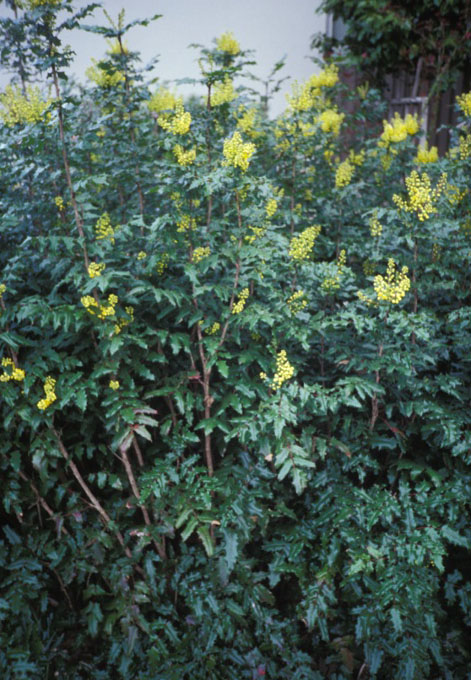Plant of the Month: August 2002
|
| Oregon Grape |
| Mahonia Aquifolium (Pursh) Nutt. |
= Berberis Aquifolium Nutt.
|
| Oregon Grape is an evergreen shrub, not related to the deciduous vine that is original plant called "grape." But its fruit clusters indeed resemble those of small Concord grapes. Other names are: holly grape, shining Oregon-grape, Oregon grape holly, Washington holly, ash barberry, and holly-leaved mahonia. |
| This member of the Barberry Family (BERBERIDACEÆ) is a good example of a plant that has two correct scientific names: you can choose to put it in the genus Berberis or Mahonia. Most botanists prefer to keep it in Berberis (more than 500 species), but the majority of horticulturists segregate the genus Mahonia (about 100 species), that was created by Thomas Nuttall in 1818, commemorating prominent Irish-American horticulturist Bernard M'Mahon (1775 - 1816). Mahonia is like Berberis but the stems are thornless, the leaves are always evergreen, pinnately compound, and the flowers are in distinctive clusters. Also, Mahonia species on the whole are more cold-tender than those of Berberis. Hybrids between the two genera have been graced with the name Mahoberberis. |
| Discovered by Meriwether Lewis in 1806 on the Columbia River, this species was named Berberis Aquifolium in 1814 (Aquifolium is the ancient Latin name of the holly now known botanically as Ilex Aquifolium). Tall Oregon-grape is the state flower of Oregon; it ranges from B.C. into California, favoring more open, drier sites than its cousin the Low Oregon-grape (Mahonia nervosa), and is less common, but far more variable. And, unlike the low species, it is widely planted; various cultivars have been named (such as Apollo, Atropurpurea, Compactum, Golden Abundance, King's Ransom, La Rocaille, Madison Park, Mayhan Strain, Moseri, Orange Flame, Smaragd) and hybrids exist too, such as Aldenhamensis and Heterophylla. |
| Tall Oregon-grape forms compact clumps or patches, that grow taller than its low cousin, 5 to 15 feet --or rarely more, making small trees with trunks up to 6 inches thick, at least near the ground. It spreads by root suckers and from seeds. It is easily grown, tolerates pruning, and though it can become diseased with unsightly rust and mildew, it rarely dies. |
| The leaves consist of 5 to 9 (13) thin leaflets, variably spiny and glossy, sometimes turning purplish in winter. From February into May, find plump 3 inch high clusters of sweetly scented bright yellow flowers. Some people liken the scent to that of Lily of the Valley, others to honey. The first deep blue, juicy, sour berries ripen in late June; many are available thereafter. Mammals and some birds eat the berries, so seedlings occur often under bird perches. The berries yield a sour purple juice valuable for making jelly, nutritious popsicles, or whatever else a creative cook can dream up. |
Though edible (like Low Oregon-grape), Tall Oregon-grape flowers, tender young leaves, and berries, are inferior in flavor, which is tainted with bitterness. Wildcrafters dig the roots, dry them and sell them to medicinal herb vendors. The primary active constituent is the alkaloid berberine, potentially poisonous in great quantity but valuable in proper doses. Oregon grape is used as a bitter tonic (it is related to the herb goldenseal), and has proved useful for treating skin problems, syphilis, dysentery and the like. Oregon grape also has been used to make a strong yellow dye. And its foliage is used in floristry.
Back |

Oregon Grape scan by ALJ
|

Oregon Grape in flower photo by ALJ
|

Low Oregon-grape photo by Emenke
|

Low Oregon-grape in flower photo by ALJ
|
|
|

